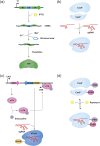Programmable Genome Editing Tools and their Regulation for Efficient Genome Engineering
- PMID: 28179977
- PMCID: PMC5279741
- DOI: 10.1016/j.csbj.2016.12.006
Programmable Genome Editing Tools and their Regulation for Efficient Genome Engineering
Abstract
Targeted genome editing has become a powerful genetic tool for studying gene function or for modifying genomes by correcting defective genes or introducing genes. A variety of reagents have been developed in recent years that can generate targeted double-stranded DNA cuts which can be repaired by the error-prone, non-homologous end joining repair system or via the homologous recombination-based double-strand break repair pathway provided a suitable template is available. These genome editing reagents require components for recognizing a specific DNA target site and for DNA-cleavage that generates the double-stranded break. In order to reduce potential toxic effects of genome editing reagents, it might be desirable to control the in vitro or in vivo activity of these reagents by incorporating regulatory switches that can reduce off-target activities and/or allow for these reagents to be turned on or off. This review will outline the various genome editing tools that are currently available and describe the strategies that have so far been employed for regulating these editing reagents. In addition, this review will examine potential regulatory switches/strategies that can be employed in the future in order to provide temporal control for these reagents.
Keywords: CRISPR/Cas9; Hammerhead ribozyme; Meganuclease; Regulatory switch; TALEN; Zinc finger nuclease.
Figures



Similar articles
-
Gene Editing in Clinical Practice: Where are We?Indian J Clin Biochem. 2019 Jan;34(1):19-25. doi: 10.1007/s12291-018-0804-4. Epub 2019 Jan 1. Indian J Clin Biochem. 2019. PMID: 30728669 Free PMC article. Review.
-
CRISPR-Cas9-Mediated Genome Editing in Leishmania donovani.mBio. 2015 Jul 21;6(4):e00861. doi: 10.1128/mBio.00861-15. mBio. 2015. PMID: 26199327 Free PMC article.
-
Potential Roles of the Retinoblastoma Protein in Regulating Genome Editing.Front Cell Dev Biol. 2018 Jul 31;6:81. doi: 10.3389/fcell.2018.00081. eCollection 2018. Front Cell Dev Biol. 2018. PMID: 30109230 Free PMC article. Review.
-
INDEL detection, the 'Achilles heel' of precise genome editing: a survey of methods for accurate profiling of gene editing induced indels.Nucleic Acids Res. 2020 Dec 2;48(21):11958-11981. doi: 10.1093/nar/gkaa975. Nucleic Acids Res. 2020. PMID: 33170255 Free PMC article. Review.
-
Non-Homologous End Joining and Homology Directed DNA Repair Frequency of Double-Stranded Breaks Introduced by Genome Editing Reagents.PLoS One. 2017 Jan 17;12(1):e0169931. doi: 10.1371/journal.pone.0169931. eCollection 2017. PLoS One. 2017. PMID: 28095454 Free PMC article.
Cited by
-
Variability in genome-engineering source materials: consider your starting point.Synth Biol (Oxf). 2023 Mar 10;8(1):ysad003. doi: 10.1093/synbio/ysad003. eCollection 2023. Synth Biol (Oxf). 2023. PMID: 36960426 Free PMC article. Review.
-
Recent advances in the CRISPR genome editing tool set.Exp Mol Med. 2019 Nov 5;51(11):1-11. doi: 10.1038/s12276-019-0339-7. Exp Mol Med. 2019. PMID: 31685795 Free PMC article. Review.
-
(Epi)genetic Modifications in Myogenic Stem Cells: From Novel Insights to Therapeutic Perspectives.Cells. 2019 May 9;8(5):429. doi: 10.3390/cells8050429. Cells. 2019. PMID: 31075875 Free PMC article. Review.
-
Programmable Molecular Scissors: Applications of a New Tool for Genome Editing in Biotech.Mol Ther Nucleic Acids. 2019 Mar 1;14:212-238. doi: 10.1016/j.omtn.2018.11.016. Epub 2018 Dec 6. Mol Ther Nucleic Acids. 2019. PMID: 30641475 Free PMC article. Review.
-
Recent Developments in Gene Therapy for Neovascular Age-Related Macular Degeneration: A Review.Biomedicines. 2023 Dec 5;11(12):3221. doi: 10.3390/biomedicines11123221. Biomedicines. 2023. PMID: 38137442 Free PMC article. Review.
References
Publication types
LinkOut - more resources
Full Text Sources
Other Literature Sources
